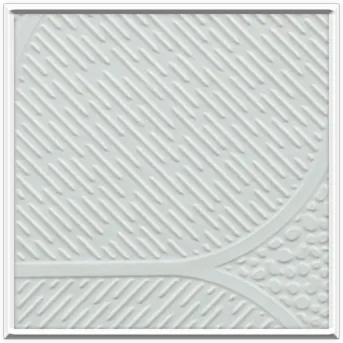- Afrikaans
- Albanian
- Amharic
- Arabic
- Armenian
- Azerbaijani
- Basque
- Belarusian
- Bengali
- Bosnian
- Bulgarian
- Catalan
- Cebuano
- Corsican
- Croatian
- Czech
- Danish
- Dutch
- English
- Esperanto
- Estonian
- French
- German
- Greek
- Hindi
- Indonesian
- irish
- Italian
- Japanese
- Korean
- Lao
- Malay
- Myanmar
- Norwegian
- Norwegian
- Polish
- Portuguese
- Romanian
- Russian
- Serbian
- Spanish
- Swedish
- Thai
- Turkish
- Ukrainian
- Uzbek
- Vietnamese
दिसम्बर . 07, 2024 09:25 Back to list
what is a grid ceiling
Understanding Grid Ceilings A Comprehensive Overview
In modern architectural design, the term grid ceiling has become increasingly popular, particularly in commercial spaces, offices, and even residential settings. But what exactly is a grid ceiling, and why is it favored by architects and designers alike?
A grid ceiling, also known as a suspended ceiling or drop ceiling, consists of a framework of metal grids that support acoustical tiles or panels. This design creates a visually appealing and functional ceiling space that can accommodate essential building elements like plumbing, electrical wiring, and HVAC systems without compromising aesthetic quality.
Structure and Components
The base of any grid ceiling is the grid system itself, typically made of lightweight metals such as aluminum or galvanized steel. This grid is suspended from the structural ceiling, allowing for an air gap between the two layers. The grid is designed to hold panels, which can be made from various materials, including mineral fiber, metal, or even wood. The panels are easily removable, granting access to the infrastructure above for maintenance or upgrades without the need for extensive renovations.
Some additional components of grid ceilings include
1. Tile Panels These come in various textures, colors, and finishes. Acoustic tiles, for example, are specifically designed to reduce sound reverberation, enhancing office productivity and comfort. 2. Edge Molding This is used to finish the perimeter of the grid ceiling. It provides a polished look while ensuring the panels fit securely within the grid system.
3. Lighting Fixtures Many grid ceiling designs incorporate recessed lighting to maintain a clean and modern appearance. These fixtures are seamlessly integrated into the grid, enhancing aesthetic appeal while providing necessary illumination.
4. Acoustic Treatments Sound-absorbing materials can be applied to both panels and the structural ceiling to further enhance noise reduction in large spaces, a common consideration in open-plan offices and conference rooms.
Advantages of Grid Ceilings
what is a grid ceiling

Grid ceilings come with a host of benefits, which explain their popularity in various settings
1. Flexibility and Accessibility One of the most significant advantages of grid ceilings is their adaptability. When changes to electrical or plumbing systems are necessary, the removable panels make it easy to access these systems without extensive construction work.
2. Aesthetic Appeal With a wide range of tile options available, grid ceilings can be customized to align with the design vision of any space. From minimalist white tiles to intricate patterned designs, the possibilities are endless.
3. Acoustic Control In environments where noise reduction is essential, such as offices, schools, or hospitals, grid ceilings equipped with acoustic tiles can significantly improve sound quality and reduce distractions.
4. Energy Efficiency By allowing additional insulation and HVAC infrastructure above the ceiling, grid ceilings can help regulate temperatures, contributing to improved energy efficiency and lower utility costs.
5. Cost-Effectiveness Compared to traditional plaster or drywall ceilings, grid ceilings are generally more cost-effective in both material and labor. The installation process is quicker, and the materials are often less expensive.
Disadvantages of Grid Ceilings
While grid ceilings offer many benefits, they also have potential downsides. For instance, the aesthetics of grid ceilings might not fit every design vision, particularly in high-end residential projects where seamless plaster ceilings may be preferred. Additionally, if not installed properly, grid ceilings can sag or become misaligned, which can detract from their appearance and functionality.
Final Thoughts
In summary, grid ceilings provide a practical and visually appealing solution for both commercial and residential settings. Their versatility, ease of maintenance, and aesthetic options make them a popular choice among architects and interior designers. As the architectural landscape continues to evolve, grid ceilings will likely remain a staple feature due to their myriad benefits and adaptability. Whether you're considering a new office space or renovating your home, the incorporation of a grid ceiling could greatly enhance the functionality and appearance of your environment.
-
Transform Interiors with PVC Gypsum Ceiling: A Stylish, Durable, and Moisture-Resistant SolutionNewsMay.19,2025
-
The Smart Interior Upgrade: Discover the Durability and Versatility of Gypsum Ceiling Access Panel SolutionsNewsMay.19,2025
-
The Smart Choice for Interior Design: Discover the Value of PVC Gypsum Ceiling SolutionsNewsMay.19,2025
-
Mineral Fiber Ceiling Tiles: The Smart Blend of Performance and AestheticsNewsMay.19,2025
-
Mineral Fiber Ceiling Tiles: The Superior Choice Over Gypsum for Sound and Fire SafetyNewsMay.19,2025
-
Mineral Fiber Ceiling Tiles: Eco-Friendly Strength and Style for Every CeilingNewsMay.19,2025







